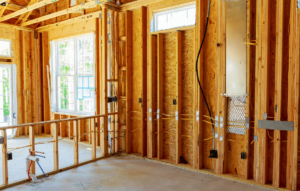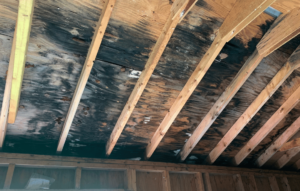In an age where our homes are crammed with high-tech devices and the trappings of modernity, it’s easy to overlook the hidden dangers lurking in our living spaces. Building biology, a discipline that focuses on creating healthy and sustainable environments, shines a spotlight on these often-overlooked threats. Two of the most significant issues addressed by building biologists are electromagnetic fields (EMFs) and mold – both of which can have profound impacts on our health and well-being.
Whether it’s the invisible waves from your Wi-Fi router or the mold spores hidden behind your walls, these hazards can quietly compromise the safety of your home. In this blog, we’ll explore how building biology can help you protect your home from these unseen dangers, offering practical solutions to ensure your living space is as healthy as it is comfortable.
Understanding Building Biology
Building biology is more than just a buzzword; it’s a pioneering approach to creating living spaces that prioritize human health and environmental sustainability. Originating in Germany in the mid-20th century, building biology emerged as a response to the growing concerns about the impact of modern construction practices on human health. Unlike traditional building methods that focus primarily on aesthetics and functionality, building biology takes a holistic view, considering the intricate relationship between our homes and our well-being.
At its core, building biology is about creating environments that support and enhance the health of the occupants. It looks at every aspect of a building, from the materials used in construction to the electromagnetic fields generated by everyday devices. By addressing these factors, building biology seeks to minimize the harmful effects of modern living and promote a healthier, more sustainable way of life.
One of the key principles of building biology is the importance of air quality. Proper ventilation, the use of non-toxic materials, and the avoidance of pollutants are all crucial in maintaining a healthy indoor environment. Additionally, this field emphasizes the need to reduce exposure to harmful electromagnetic fields (EMFs) and ensure that moisture control is properly managed to prevent mold growth. These aspects, often overlooked in conventional construction, are incredibly important pieces in protecting both the physical and mental health of those who live and work within these spaces.
The EMF Problem in Modern Homes
In our tech-centered world, electromagnetic fields (EMFs) have become an unavoidable part of daily life. From the Wi-Fi networks that keep us online to the cell towers that enable our constant communication, EMFs are everywhere. While these  technologies have undeniably made life more convenient, they also come with a hidden cost: potential risks to our health.
technologies have undeniably made life more convenient, they also come with a hidden cost: potential risks to our health.
Research has suggested that prolonged exposure to EMFs may contribute to a range of health issues, including sleep disturbances, headaches, and even long-term conditions like chronic fatigue and anxiety. The concern is especially pressing in our homes, where we spend a significant portion of our time and are often surrounded by multiple EMF sources – smart meters, wireless routers, and even the wiring in our walls.
Building biology steps in as a powerful tool to assess and mitigate these risks. A building biologist can conduct a thorough evaluation of your home, identifying sources of EMF exposure and recommending practical solutions to minimize their impact. These solutions might include shielding techniques, rearranging the layout of your home to create EMF-free zones, or even simple changes like reducing the use of wireless devices during sleep hours.
For those looking to take immediate action, innovative solutions like Aires Tech’s

scientifically backed EMF protection devices can be a great starting point. Their products are designed to reduce the harmful effects of electromagnetic fields. Whether used in your home or on the go, Aires Tech devices offer a practical way to address EMF exposure proactively.
By addressing the EMF problem, building biology helps create a living environment that supports your health, reducing the potential for EMF-related health issues and promoting better sleep, lower stress levels, and overall well-being.
The Hidden Mold Issue
Mold is often referred to as the silent intruder because it can grow unnoticed in hidden corners of your home, quietly undermining your health. Mold thrives in damp, poorly ventilated areas, and once it takes hold, it can be difficult to eradicate. The health effects of mold exposure can range from mild allergic reactions, like sneezing and skin irritation, to more serious conditions such as asthma, respiratory infections, and even long-term immune system damage.
The problem with mold is that it doesn’t just appear in obvious places like bathroom tiles or basements. It can also lurk behind walls, under floors, or in attics, where leaks or condensation create the perfect breeding ground. Even small amounts of moisture can lead to significant mold growth, making it a pervasive issue in many homes.
Building biology offers a comprehensive approach to preventing and addressing mold. A building biologist will assess your home for potential moisture problems, identify areas where mold might be growing, and provide recommendations for remediation. This might include improving ventilation, repairing leaks, and choosing building materials that resist moisture accumulation.
By focusing on moisture control and proper ventilation, building biology not only helps eliminate existing mold but also can help to prevent future growth. This proactive approach ensures that your home remains a safe and healthy environment, free from the hidden dangers of mold.
Integrating Building Biology into Your Home
Now that you understand the potential threats posed by EMFs and mold, you might be wondering how to incorporate building biology principles into your own living space. The good news is that you don’t have to start from scratch or make drastic changes to see significant benefits. Even small adjustments can make a big difference in creating a healthier home.
Practical Steps for Homeowners
- Evaluate EMF Exposure: Begin by assessing the EMF sources in your home. This might involve moving your Wi-Fi router away from sleeping areas, reducing the use of wireless devices, or considering wired alternatives for internet and communication. Simple changes like turning off electronic devices when not in use can do a lot to reduce your EMF exposure.
- Control Moisture and Ventilation: To combat mold, ensure your home has proper ventilation, especially in areas prone to moisture like bathrooms, kitchens, and basements. Regularly check for leaks and address them immediately. If you live in a humid climate, using dehumidifiers can help keep moisture levels in check.
- Choose Non-Toxic Materials: When renovating or building, opt for materials that are free from harmful chemicals and toxins. Natural building materials not only improve indoor air quality but also tend to reduce the risk of mold growth.
- Regular Inspections: Schedule regular inspections with a certified building biologist to assess and address any potential issues before they become significant problems. A building biologist can offer tailored advice and solutions specific to your home’s needs.

Cost vs. Benefits
While some building biology interventions might seem costly upfront, the long-term benefits to your health and well-being are invaluable. Investing in these practices can prevent costly health issues and home repairs down the line, making it a worthwhile investment. Also, you’ll just feel better being in a healthier environment and knowing that you’re doing your best.
By integrating building biology principles into your home, you’re not just making your living space safer; you’re actively cultivating a lifestyle that prioritizes health, well-being, and sustainability.
The Future of Building Biology
As awareness of environmental health continues to grow, building biology is poised to play an increasingly important role in how we design, construct, and maintain our homes. The principles of building biology are not just about addressing current issues like EMFs and mold – they are also about preparing for the future, as new technologies and environmental challenges emerge.
Emerging Trends
- Smart Home Technology: While smart devices offer convenience, they also introduce new sources of EMFs and potential health concerns. Building biologists are at the forefront of finding ways to integrate smart technology into homes without compromising health, using shielding techniques and other innovative solutions.

- Sustainable Building Materials: The push towards sustainability is leading to the development of new building materials that are both environmentally friendly and healthier for occupants. These materials minimize the off-gassing of harmful chemicals and reduce the risk of mold and other health hazards.
- Holistic Home Design: The future of building biology lies in designing homes that support overall well-being, from the ground up. This includes everything from the layout of rooms to the choice of materials, ventilation systems, and lighting – all designed to promote health and reduce environmental impact.
Challenges and Opportunities
- Wider Adoption: One of the biggest challenges for building biology is increasing awareness and adoption of its principles. While the benefits are clear, many homeowners and builders are still unfamiliar with the practice. Education and advocacy will be key to making building biology more mainstream.
- Balancing Technology and Health: As technology advances, the challenge will be to balance the benefits of new innovations with the potential risks to health. Building biologists will continue to play a crucial role in finding this balance, ensuring that our homes remain safe, healthy environments.
Building Biology’s Role in Environmental Health
Building biology isn’t just about improving individual homes – it’s about contributing to broader environmental health goals. By promoting sustainable practices, reducing chemical exposure, and addressing health risks like EMFs and mold, building biology is helping to create a healthier planet for future generations.

Closing Thoughts
Building biology offers a unique and powerful approach to creating healthier living spaces. By addressing the unseen dangers of EMFs, mold, and other environmental hazards, it helps to ensure that our homes are not just places of comfort but also genuine sanctuaries for our well-being. Whether you’re concerned about the long-term effects of electromagnetic exposure or the silent threat of mold, integrating the principles of building biology into your home is a proactive step towards a safer and healthier future.
Incorporating building biology into your life doesn’t have to be overwhelming. With the guidance of a certified building biologist and a few practical changes, you can significantly reduce the risks associated with modern living environments. As more people become aware of the importance of these practices, building biology will continue to grow, offering innovative solutions to the challenges of maintaining a healthy home.
Your home should be a place of security and peace – a place where you can relax without worrying about any hidden dangers. By embracing the principles of building biology, you can protect your home and, more importantly, the health of everyone who lives there.










